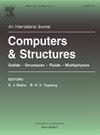用于薄板结构实时形状传感和结构健康监测的四边形反演板元素
IF 4.4
2区 工程技术
Q1 COMPUTER SCIENCE, INTERDISCIPLINARY APPLICATIONS
引用次数: 0
摘要
反有限元法(iFEM)是形状传感和结构健康监测(SHM)应用中的一种强大工具,与现有方法相比具有明显优势。在本研究中,通过一种子参数方法,使用工程结构的双线性和非正规立方赫米特基函数,制定了四边形反向板元素,可将其建模为薄板。数值验证涉及平面内、平面外和混合一般加载条件下的密集和假定稀疏传感器布置。iFEM 分析显示出与分析和高保真有限元参考解的高效单调收敛性。在成功进行数值验证后,考虑到拉伸和横向加载条件下潜伏的次表面缺陷导致的微小几何不连续性和结构刚度降低,进行了缺陷检测分析。在传感器稀疏布置的情况下,反演公式成功地解决了模拟缺陷的存在。所提出的反板元素在形状传感剖面的全场重建方面非常精确,在薄板结构的缺陷识别和量化方面也非常可靠。本文章由计算机程序翻译,如有差异,请以英文原文为准。
A quadrilateral inverse plate element for real-time shape-sensing and structural health monitoring of thin plate structures
The inverse finite element method (iFEM) emerged as a powerful tool in shape-sensing and structural health monitoring (SHM) applications with distinct advantages over existing methodologies. In this study, a quadrilateral inverse-plate element is formulated via a sub-parametric approach using bi-linear and non-conforming cubic Hermite basis functions for engineering structures, which can be modeled as thin plates. Numerical validation involves dense and assumed sparse sensor arrangements for in-plane, out-of-plane, and mixed general loading conditions. iFEM analysis reveals efficient monotonic convergence to analytical and high-fidelity finite element reference solutions. After successful numerical validation, defect detection analysis is performed considering minute geometric discontinuities and structural stiffness reduction because of latent subsurface defects under tensile and transverse loading conditions. The inverse formulation successfully resolves the presence of simulated defects under a sparse sensor arrangement. The proposed inverse-plate element is accurate in the full-field reconstruction of shape-sensing profiles and reliable in defect identification and quantification in thin plate structures.
求助全文
通过发布文献求助,成功后即可免费获取论文全文。
去求助
来源期刊

Computers & Structures
工程技术-工程:土木
CiteScore
8.80
自引率
6.40%
发文量
122
审稿时长
33 days
期刊介绍:
Computers & Structures publishes advances in the development and use of computational methods for the solution of problems in engineering and the sciences. The range of appropriate contributions is wide, and includes papers on establishing appropriate mathematical models and their numerical solution in all areas of mechanics. The journal also includes articles that present a substantial review of a field in the topics of the journal.
 求助内容:
求助内容: 应助结果提醒方式:
应助结果提醒方式:


